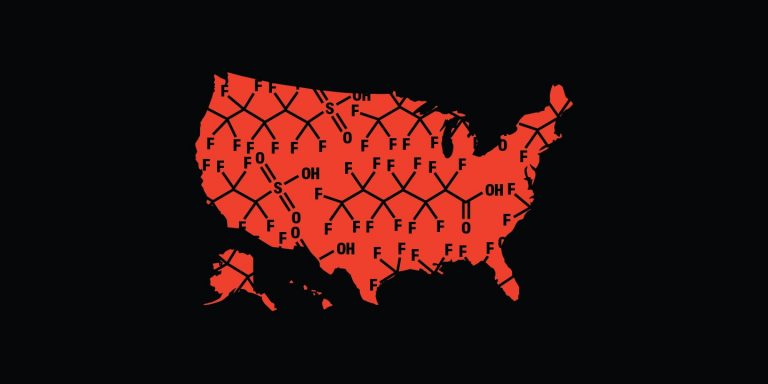PFAS Nation: Toxic discharges suspected from almost 500 industrial facilities across U.S.
By Jared Hayes, Scott Faber, Dave Andrews, & Audrey Lothspeich | June 11, 2019

Read the full EWG report by Jared Hayes, Scott Faber, Dave Andrews, and Audrey Lothspeich
“At least 475 industrial facilities across the nation could be discharging the toxic fluorinated compounds known as PFAS into the air and water, according to an EWG analysis of government data.
EWG analyzed two online databases from the Environmental Protection Agency, as well as data from a survey by the state of New York, and identified 475 unique industrial sites that are known to produce or use PFAS, or which are suspected of using PFAS.
Independent scientific research has linked low doses of some PFAS compounds to weakened childhood immunity, cancer, kidney and thyroid disease, and other serious health problems.
EWG’S analysis and interactive map identifies many industrial facilities that could be discharging PFAS. Some have already been confirmed as a source of drinking water contamination, but tap water near other listed facilities may not have been tested.
https://www.ewg.org/interactive-maps/2019_suspected_industrial_discharges_of_pfas/map/
Our data comes from three sources:
- The EPA’s Chemical Data Reporting Rule, which lists 28 industrial facilitiesthat have disclosed the production and use of large quantities of PFAS chemicals. These include well-known companies such as Chemours (a spinoff of DuPont), 3M and Dow Corning. These facilities are known to produce or use PFAS chemicals but are not required to disclose through the Toxics Release Inventory whether they are releasing PFAS chemicals into the air or water.
- The EPA’s Enforcement and Compliance History Online, or ECHO, from which EWG identified 419 industrial facilities that, based on the type of industry, couldbe using PFAS in their production process. This includes tanneries, carpet and rug mills, coated-paper-product plants, electroplating facilities, semiconductor factories and wire manufacturers.
- A 2017 survey by the New York Department of Environmental Conservation, which found 28 facilities in the state that reported past use of PFOA or PFOS – the two most notorious members of the PFAS family of thousands of compounds – including 13 that currently store PFOA and PFOS onsite.
Our count of industrial sites does not include 446 public water systems known to be contaminated with PFAS, more than 100 military installations with known or suspected water contamination identified by the Pentagon, or hundreds of Defense Department fire training stations with known or suspected use of PFAS-based firefighting foam, identified by the Intercept.
Many of the industrial sites identified in our analysis closely correlate with known PFAS contamination sites previously identified and mapped by EWG and Northeastern University.
There are no restrictions currently on industrial PFAS discharges under either the federal Clean Water Act or the federal Clean Air Act. Rep. Haley Stevens (D-Mich.) has introduced a bill to direct EPA to regulate PFAS air emissions as hazardous air pollutants. Other lawmakers plan to introduce legislation to regulate PFAS water discharges as toxic pollutants.
In addition, chemical companies are not currently required to report industrial releases of PFAS through the federal Toxic Release Inventory, or TRI. Of the industrial facilities known or suspected of using PFAS, EWG found that 396 are already reporting other toxic chemical releases through the TRI. Sens. Shelley Moore Capito (R-W.Va.) and Kirsten Gillibrand (D-N.Y.) and Reps. Antonio Delgado (D-N.Y.) and Mike Gallagher (R-Wisc.) introduced legislation to require some or all PFAS chemicals to be reported through the TRI.
Firefighting foam is a major source of PFAS water pollution, and both the House and Senate versions of the National Defense Authorization bill include provisions to replace PFAS-based firefighting foams with fluorine-free alternatives. The reauthorization bill for the Federal Aviation Administration recently allowed civilian airports to use fluorine-free firefighting foam.
Other sources of PFAS contamination include sewage and industrial sludge and everyday products like food packaging and cosmetics.”
This content provided by the PFAS Project.
Location:
Topics: